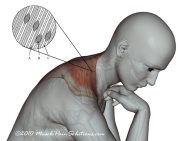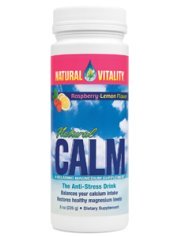Trigger Point Treatment
What is a trigger point?
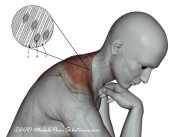
Before we can get into trigger point treatment, it is important to understand what a trigger point is. Basically, it is a "knot" in the muscle that creates pain both local and referred to distant areas in the body. To the right, you can see an image that shows a trigger point enlarged. Click here for a complete explanation of myofascial trigger points.
Where do I find them?
Briefly, they occur at the center of a muscle fiber, which is not necessarily at the center of a whole muscle. You will need a manual to guide you to the trigger points since the pain you feel is often distant from the actual trigger point causing the pain. Until you are able to get the manual, try using this website to give you an idea of where your pain might be coming from.
Trigger Point Treatment Options
When it comes to trigger point treatment, there are several ways you can go about it. I would like to share all of these ways because they are not often explained to non-professionals. However, I have taught these methods to many of my patients and they have been able to successfully use them. I also think that trigger points are a very under-treated problem, and I would like to give you the tools to be able to treat them yourself, or find someone who understands them well enough to treat them.
Self Massage: Deep Stroking Massage
This is probably the easiest trigger point treatment type to learn and use. It can be done anywhere with few or no tools. Basically, you use a firm pressure and rub the skin over the underlying muscles in such a way where your fingers (or massage tools) don't move the skin. This is the type of massage is advocated by Clair Davis in The Trigger Point Therapy Workbook. The massage is done repeatedly throughout the day which slowly eliminates the trigger points.
Self Massage: Trigger Point Pressure Release
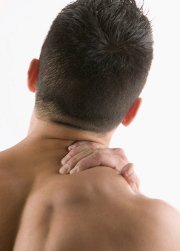
This is a gentler way to work on your trigger points, using gentle static pressure. It is better for sensitive areas. I have also been finding that it is a better way to start out for most people when they are having significant pain, because it does not increase that pain much. Many people do better using this as their primary treatment method. Look through this page to understand how it works.
Pin and Stretch
With pin and stretch massage, you use finger pressure to pin the trigger point and then you stretch the muscle away to its fully lengthened position. This is a bit harder to do because you need to know where the trigger point is, as well as how to stretch the muscle. Feel free to pin the trigger point and then move the body part to see if you can stretch it out... very effective, but you often need someone to help you with the "harder to reach" muscles. Here is a database of hundreds of stretches to choose from.
Home Stretching Program
Janett Travel, MD also recommended a home stretching program as a part of trigger point treatment, which she would have patients perform between sessions of spray and stretch. She discovered that a stretching frequency of every 60-90 minutes of the effected muscle was ideal. This is to retrain the brain that there is more movement available so it stops inhibiting the muscle. It is important to stretch only to the point of feeling tension, and NOT into pain, because the pain signal will inhibit the stretch and reactivate trigger points.
Ice and Stretch
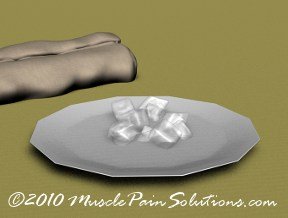
This is an amazingly effective treatment that I have recently discovered. It is based on Janett Travell M.D.'s work with spray and stretch. She discovered that she could distract the nervous system with a cold evaporating spray, and while the pain was "shut off" at the spinal cord level, she could gently stretch the muscle and eventually eliminate trigger points. The spray that she used was a chlorofluorocarbon, and was later banned due to environmental concerns. Because of this, the practice has fallen into disuse. However, as I was studying her work, I noticed that she said the spray could be imitated by stroking with the edge of ice. I have since been experimenting with this treatment, and often get amazing results. Click here to learn more about it.
Helpful Professional Massage Techniques
There are a number of named massage techniques that may deal with trigger points as well. If you already have a massage therapist, ask if they know about trigger point therapy, and if they will help you come up with a self treatment plan for your pain. Though I don't practice these techniques myself, I understand that deep tissue massage, Rolfing, and ART (Active Release Technique) are good at deactivating trigger points.
Other Trigger Point Treatment Techniques
If massage and stretching are not enough to get rid of your trigger points, you may need to seek professional assistance. Here are other trigger point treatment types that I have found to be effective in treating these problems, some of which you can try yourself.
Gua Sha and Graston
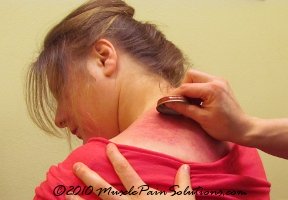
Graston is a form of massage that is based on an ancient Chinese treatment called Gua Sha, where areas of pain or congestion are rubbed with a spoon or shell. The reasoning is to remove stagnation of Chi, or energy. With Graston, blunt metal instruments are used to break up scar tissue in muscles and their coverings. Though not specifically a trigger point treatment, I have found this to be a helpful adjunct to other treatments listed because it gets rid of the scar tissue component of the trigger point complex. It is best to find a practitioner who can help you with this... some chiropractors, physical therapists, and acupuncturists may be trained in Graston or Gua Sha. If you do not have a practitioner available, you can try it yourself.
Laser Therapy
Another interesting discovery that I made in my journey to try to heal muscle pain is cold laser therapy. A chiropractor friend of mine reported using laser on trigger points, so I started using it on trigger points that would not respond to the above detailed treatments. I even used it on my own sternocleidomastoid muscle to get rid of headaches I was having, with great success. Many chiropractors now offer this treatment... call around to see if someone in your area can help you with this. I use the maximum dose on each spot (20 Joules) and apply it to the primary trigger points 3 times per week.
Dry Needling
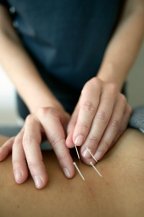
This is a great trigger point treatment option for those open to needles. I often send really resistant cases to a local acupuncturist that has begun studying this method. I have recently learned that physical therapist and chiropractors are beginning to practice a similar treatment called Intra Muscular Therapy. It is relatively new practice, requiring special training and is not in the scope of practice for all 50 states.
Trigger Point Injections
When even dry needling is not enough, I send them for injections. This method can be helpful, but is only recommended after the other methods are tried. There are many things that I would caution you when pursuing this method, including finding a skilled practitioner. Read more here.
Conclusion
There are many options available for trigger point treatment, as this problem can be difficult to beat. This is very individual, so what works for someone else may not be the right treatment for you. If you find that you have trigger points that reproduce your main pain symptoms, don't give up! Keep searching until you find the treatment that works for your body. It can often be difficult to find someone that is skilled in finding and treating trigger points effectively. Still have questions? Feel free to email me.



